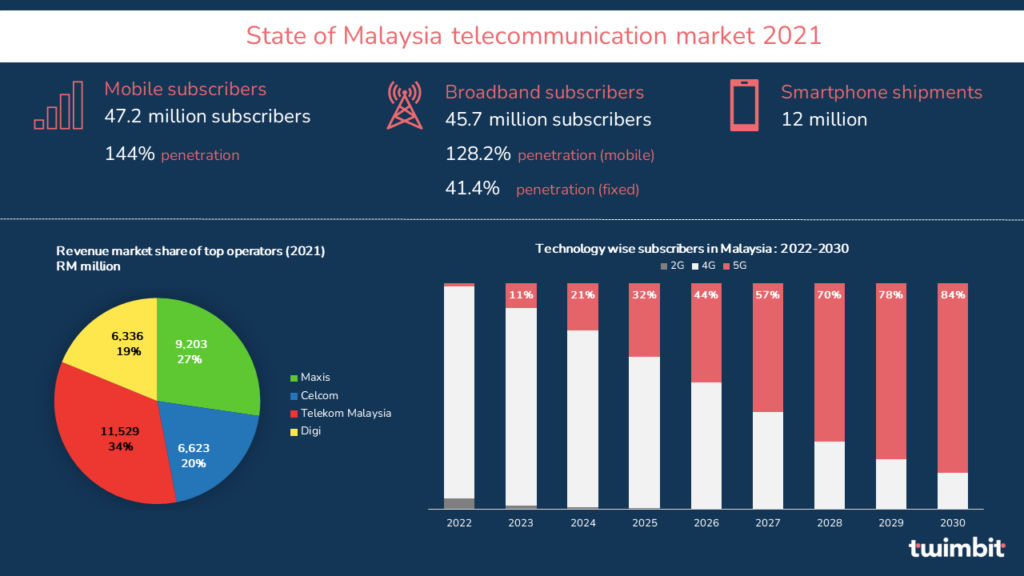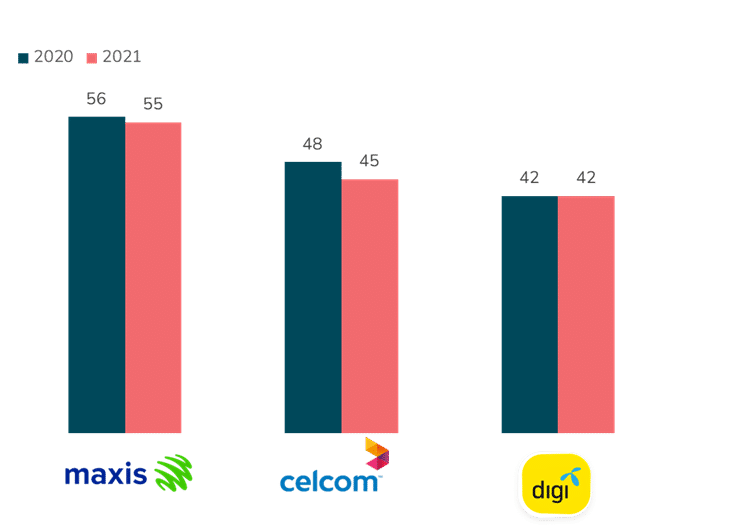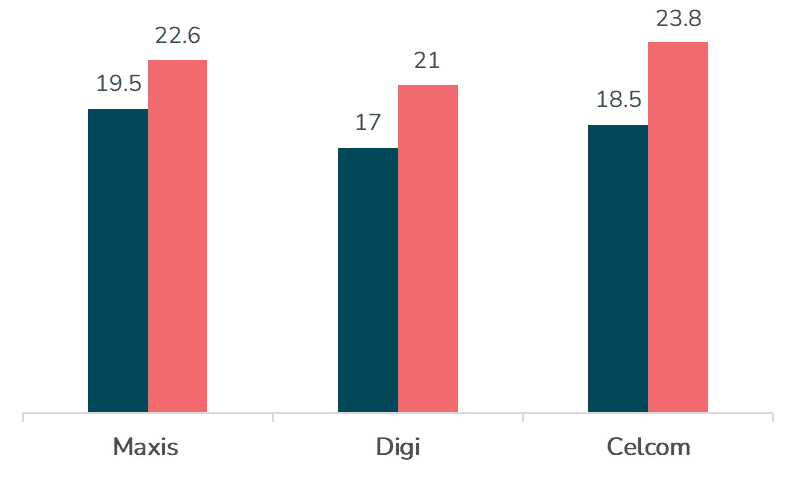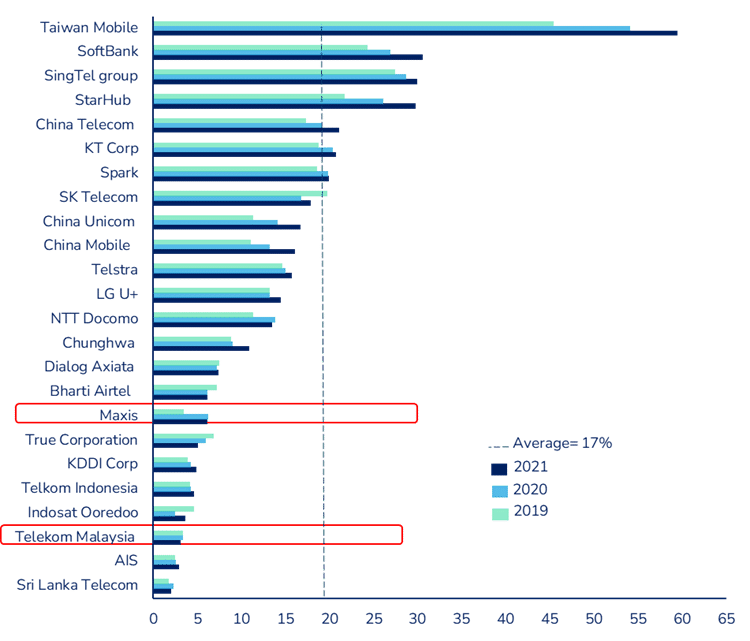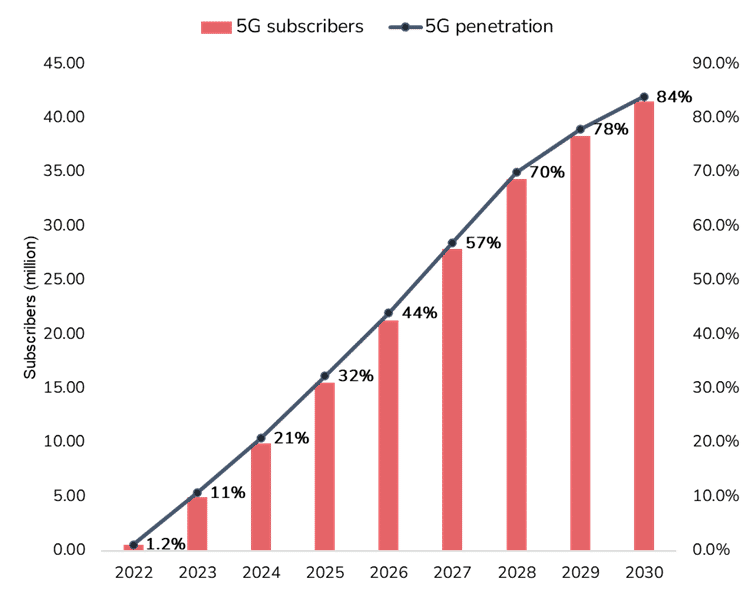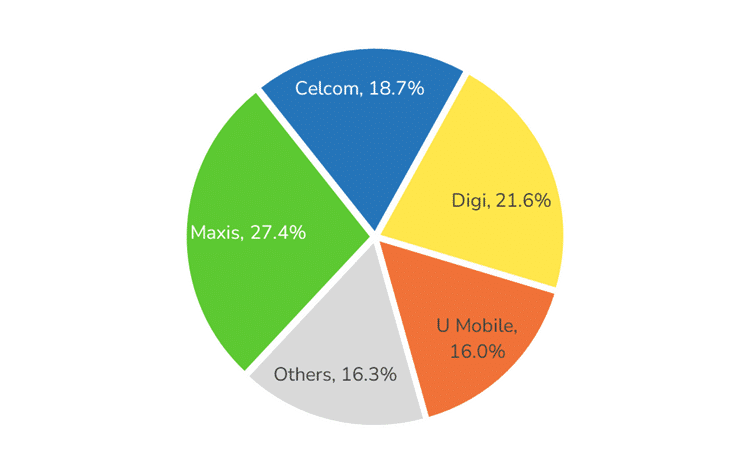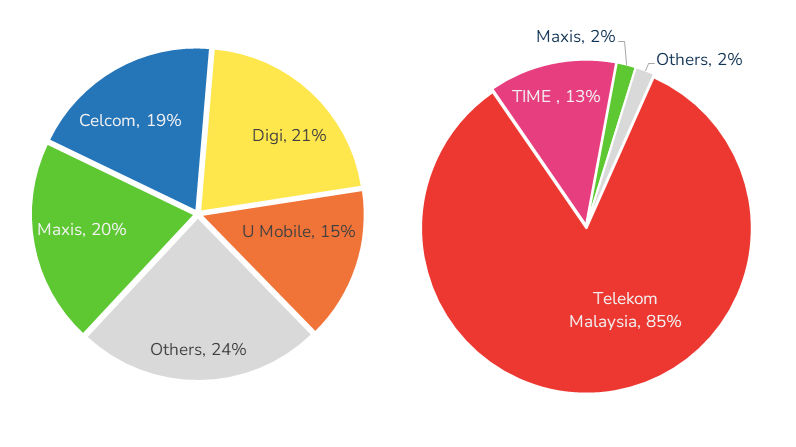The Malaysian market is poised for remarkable market transition in the next five years. The key takeaways from this insight include:
- Connectivity revenues are under pressure, service providers need to transition rapidly to content and other non-connectivity streams to bolster growth
- 5G will be the key revenue driver for the industry. The Single Wholesale Network for 5G, allows existing MNOs to invest their capital in developing the applications and services to drive growth.
- Shipment of 5G enabled smartphones will reach close to 10 million by 2025, up from an estimated 4.3 million in 2022.
- Fixed mobile convergence is gaining momentum as a possible differentiator for telcos such as TM. The ability to bundle cost-effective solutions can improve overall wallet share for TM.
- Additionally, TM has the opportunity to benefit the most with the ability to gain mobile market share via its leverage of the 5G mobile wholesale network.
- Consolidation will gather momentum as two of the big mobile network providers, Digi and Celcom will conclude the merger by end of 2022. The merged entity will emerge as the largest operator in the country.
The report covers the following
- Industry overview
- Top challenges
- Growth opportunities
- Key trends in the market
- Conclusion
#1 Industry snapshot
The country has a total population of 32.7 million with high mobile and broadband penetration rates. The telecom towers in the country are at an estimated of 40,700 in 2021.
The market has 4 main network operators and a single incumbent fixed-line provider (nearing to a monopoly). Here is a snapshot summarising the state of Malaysia’s telecom market
Figure 1: Key metrics of telecoms market in Malaysia in 2021
#2 Top Industry challenges
#2.1 Large number of MVNOs put pressure on pricing
Malaysia is one of Asia’s most active MVNO markets. 19 licenses have been issued to provide MVN services. MVNOs hold 14.2% of the mobile subscriber market share and have a total of 6.3 million subscribers.
#2.2 Data consumption growing, ARPU flat or declining for most operators
Telcos struggle to maintain or increase the ARPU due to the decline in mobile voice and messaging services. The overcrowded market drives price competition. As a result, data usage increases, but pricing remains low.
Figure 2: Mobile ARPU in MYR for top 3 operators
The Covid-19 pandemic acted as a major catalyst, leading to a spike in data usage in Malaysia. According to tefficient , the country has the 5th highest data usage out of 46 countries evaluated in 2021. Data usage increased by 4.3 GB per user/month to reach 19.4 GB per user/month in 2021.
Figure 3: Data consumption per GB/month for top 3 players in 2020 and 2021
#2.3 Limited success with non-connectivity service revenues
APAC telcos seek growth beyond their core (connectivity services), exploring opportunities in adjacencies (non-connectivity). Our previous study, ‘Telcos to Ace Non-Connectivity Revenues in 2021’, highlighted that 40 telcos across 15 key markets provide consistent, detailed updates on their business progress.
Malaysian operators lag their regional counterparts in capturing this opportunity. Figure 4 highlights the percentage of non-connectivity revenues for leading operators over the years. It confirms the significant growth opportunity for the telcos.
Figure 4: % of non-connectivity revenues to total revenue for APAC telcos
#3 Top growth opportunities
#3.1 Malaysia projected to have 15 million 5G subscribers by 2025
The population coverage targets specified by DNB (Malaysia’s Single Wholesale 5G network provider) are 40% by 2022, 70% by 2023 and 80% by 2024, respectively. All MNOs in Malaysia would have launched 5G services by the end of 2023.
Figure 5: 5G subscribers and penetration in Malaysia 2022-2030
#3.2 5G smartphone sales to reach 10 million units by 2025
Smartphone sales in Malaysia stagnated in 2021, mirroring the global trend of a decline due to supply chain constraints. The harsh economic environment and depreciation of the Malaysian Ringgit have added to the stagnation in the country’s smartphone sales. On the positive side, smartphone shipments are expected to rise with 5G taking a lead role.
Figure 6: Malaysia smartphone shipments (in millions) 2021-2025
twimbit estimates 5G to account for approximately 80% of smartphone shipments by 2025.
There is high 5G smartphone penetration despite the minimal availability of 5G services. Telcos also have the ability to target the over 4 million customers who already have 5G smartphones in the country. Bundling value added services and attractive 5G plans will be a key market driver for smartphone sales in the next three years.
E-commerce giants Lazada and Shopee account for a significant percentage of sales of smartphones. Their regional scale gives them better leverage on prices. This is because handset subsidies/promotions from CSPs are not as competitively designed to help gain share from the e-commerce giants.
#4 Top trends in the market
#4.1 Massive government support to reduce burden of 5G infrastructure spending
- 5G rollout has been a key focus area of Malaysia’s My Digital initiative. The government plans to invest US$ 3.7 billion (RM 15 billion) to implement 5G over the next 10 years.
- In Dec 2021, Malaysia rolled out its 5G network via a single state entity, Digital National Berhad (DNB), in contrast to opting for a competitive spectrum auction. DNB offered wholesale 5G access to the Malaysian telcos. This model suggests that the responsibility for physical infrastructure layout will remain with DNB.
- The lawmakers have allowed for the existing MNOs to take up an equity stake in DNB.
#4.2 3G sunset in Malaysia to fuel adoption of 4G & 5G
4G coverage in Malaysia was at 95.4% in 2021 and is expected to reach 96.9% by the end of 2022. As 3G technology fades away, the transition of 3G customers to a 4G network was mandatory for all operators.
Figure 7: Cellular technology subscribers in Malaysia 2022-2030
#4.3 Consolidation in the over-crowded market
The consolidation of two key MNO’s, viz., Digi and Celcom is expected to ease the pricing pressure in the highly competitive market. Axiata and Telenor group will hold equal stake (33.1% each) in the new entity. MCMC has consented to the merger, which is expected to occur by the second half of 2022.
The merged entity will come out as a stronger digital converged service provider. It will focus on better network quality and coverage via expansion, drive 5G solutions and serve opportunities in large enterprises and SMEs.
#4.4 Mobile service revenue will see marginal increase buoyed by 5G services, a new mobile number one telco will emerge by end of the year
Declining mobile voice, roaming and SMS revenues have put considerable pressure on overall revenues. 5G services provide an opportunity for the MNOs to differentiate and charge higher tariffs for a better service experience. We estimate this will help drive very low single digital revenue growth leading to 2025.
As of 2021, there were 47.2 million mobile subscribers in Malaysia at a penetration rate of 144%. Malaysia has 7 MNO’s (Mobile Network Operators) that are currently operating in the country. Out of these, 4 are GSM-based national network operators and 3 are providers that only operate on their own 4G/LTE network
Figure 8: Mobile subscriber market share in Malaysia in 2021
#4.5 Infrastructure investments will continue to drive the broadband market
As of 2021, there are 42 million mobile broadband subscribers at a penetration rate of 128% and 3.7 million fixed broadband subscribers with a penetration of 41.5% (of households).
Mobile broadband speeds aim to reach 35 Mbps, and 83% of premises nationwide will have gigabit speed of fixed broadband by the end of 2022.
As of 2021, 6.85 million premises have access to fibre broadband. Additionally, that number is expected to increase to 9 million premises by the end of 2025.
Telekom Malaysia (TM) is currently the operator with the highest fixed broadband subscriber base in Malaysia. The operator plans to expand its fibre network further to an additional 6 million premises by the end of 2022.
Figure 9: Mobile & fixed broadband subscriber market share by key operators in 2021
Conclusion
Malaysia’s telecom story is a remarkable one of the government led initiative to build a world class fiber as well as mobile broadband infrastructure. Its Single Wholesale 5G network strategy is revolutionary and will have significant ramifications on the competitive structure of the market.
After considerable uncertainty, it seems like the dust has finally settled on the issue of 5G licenses. Telcos can divert their investments to 5G enterprise use cases. The winners in the next five years will be the ones who will make the most of the market transition to 5G.












